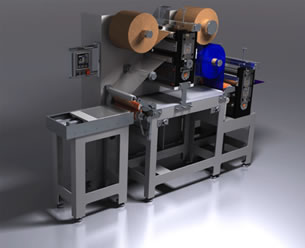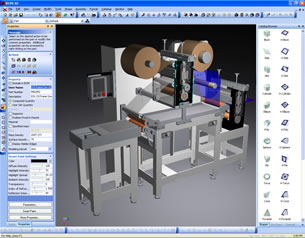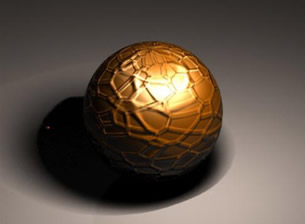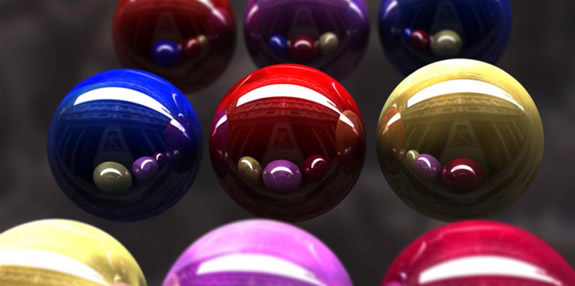Latest News
October 31, 2007
By DE Editors
 Realistic rendering showing Global Illumination, Soft Shadows, and Lighting from High Dynamic Range Images. Image courtesy of American Die Technologies. |
IronCAD, LLC’s (Atlanta, GA) latest release of IronCAD, Version 10, combines history-based parametrics and direct geometry manipulation in a 3D modeling system that gives users design freedom and enables solutions in design productivity.
The list of new features outlined on the company’s website is three miles long and animated GIFs highlight new features spanning advanced realistic rendering options, save-and-load improvements, import-export translator additions, subsystem upgrades, 2D technical drawing view creation improvements, BOM table formats, sort-reorder capabilities, and text-to-part/assembly properties.
The 3D modeling program, said to be intuitive, offers improvements to large assembly handling in 3D and 2D, and the redesigned interface provides more fluid navigation through the design environment. Its new Quick Access Property Browser lets engineers access property information and commands pertaining to selected geometry at any time.
 Screenshot showing the new Quick Access Property Browser and the updated user interface. Image courtesy of American Die Technologies. |
While IronCAD has a history structure, it doesn’t restrict the user by the history order of geometry. Items in IronCAD’s history tree can be rearranged without breaking the model or causing rebuild errors. SmartUpdate, one of IronCAD’s new features, can automatically reorder the history tree and recognize what users are trying to do.
Designed for target markets that include fabrication and assembly, high-end electronics, and suppliers of automotive, transportation, aerospace, and defense manufacturers, the improvements in IronCAD’s performance, visualization, communication, 2D and 3D environment, and interoperability all reflect both customer needs and company intentions.
“IronCAD Version 10 is full of content our users have been asking for since the release of Version 9,” says Cary O’Connor, IronCAD’s marketing director. “We take customer feedback seriously, but also take the time to consider new, unexplored areas into where we can develop IronCAD.”
“We take customer feedback seriously, but also take the time to consider new, unexplored areas into where we can develop IronCAD.” — Cary O’Connor, IronCAD, Marketing Director |
Improvements to visualization have been made with the aid of HOOPS technology from Tech Soft 3D (Berkeley, CA). 3D rotation and camera selection is now almost a real-time interaction by taking advantage of the latest OpenGL and Direct3D graphics drivers. HOOPS allows IronCAD to perform Quick Visual Loading so users can manipulate camera tools and interact with a model as it loads by using a multithreaded loading process.
2D technical drawing views benefit from HOOPS integration too. IronCAD Version 10 can create 2D views from 3D models up to 10 times faster than previous releases, especially when working with large assemblies, states the release.
IronCAD Version 10 incorporates a new realistic rendering engine enabling engineers and designers to produce photorealistic visuals, offering control of their 3D environment with options like global illumination, radiosity, and caustics. This new rendering engine also supports high dynamic range imaging (HDRI) environment maps, which help with reflections and lighting effects.
 The Shader Example demonstrates a simple procedural shader in the Bump channel of the SmartPaint Material to modify the appearance of the model without the need of images (since images may introduce tiling and pixilation). |
Users can take advantage of 3D PDFs with a new export option to create Adobe Acrobat 3D PDF files, enabling collaboration regardless of CAD system and facilitating open communication. Plus, in addition to IronCAD Version 10’s support of import and export of Granite 4.0, Wildfire 3.0, Parasolid 19, and ACIS 17 files, interoperability is further enhanced by add-on translation enhancements including new import and export options for Unigraphics version 11-18 and NX1-NX4.
Plus, all of IronCAD’s standard translator formats have been updated to the latest version of InterOp translators from Spatial (Broomfield, CO). This compatibility with Spatial, which was purchased by Dassault Systemes in late 2000, enables further high-performance 3D modeling along with professional services for design-centric markets for CAD/CAM/CAE, animation, and shipbuilding.
Other new features to IronCAD’s 2D sketching environment include constraint options that give engineers and designers the ability to exercise more control over geometry. Coincident, Fixed, and Smart Constraints are other new options available. Smart constraints automatically place common constraints on elements like chamfers, fillets, polygons, rectangles, and parallelograms, along with tangent geometry. And as constraints are added, IronCAD will display an element’s constraint status based on the degrees of freedom within a sketch.
Updates to the 3D environment, like collision detection, have been added based on customer feedback. Collision detection works in IronCAD’s Mechanism Mode to detect collisions between user-specified components, or between all components in the scene. Once a collision occurs, its area is highlighted.

This shot of DOF Spheres shows the Depth of Field capability in the Camera controls (the front and back row are out of focus while the middle is in focus).
While IronCAD V10 currently supports Windows XP and 2000, the company will release its Vista-supported version later this year or early Q1. And due to its tight integration with the Hoops 3D Technology, IronCAD will wait to incorporate Tech Soft 3D’s update version 16, which is fully supported on Vista, and release its Vista version after a full QA has been processed.
IronCAD has plans beyond IronCAD Version 10, namely to focus on developing more functionality to aid engineers in streamlining the design process and simplifying communication. This functionality will include customer-specific enhancements as well as updates aimed at making the design process more efficient and productive.
Click here for details on IronCAD Version 10, which costs $3,495 for a single seat.
Click here for a listing of IronCAD Version 10’s new features.
Click here for the trial download.
Click here for the datasheet.
Click here for the online Gallery.
Click here for earlier DE coverage of IronCAD V9 from July 2006.
Subscribe to our FREE magazine, FREE email newsletters or both!
Latest News
About the Author
DE’s editors contribute news and new product announcements to Digital Engineering.
Press releases may be sent to them via [email protected].






